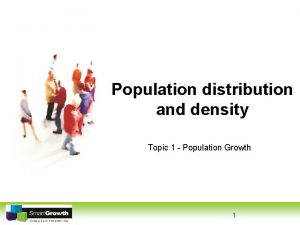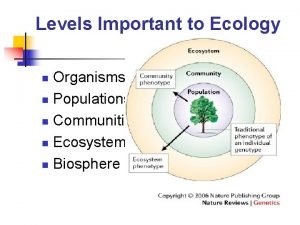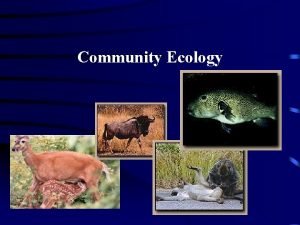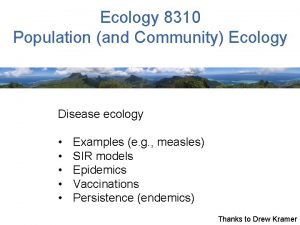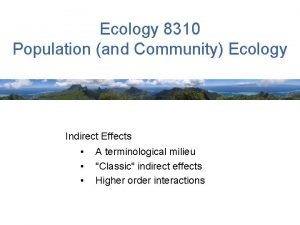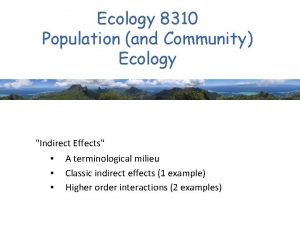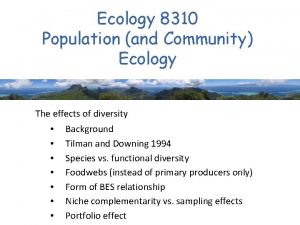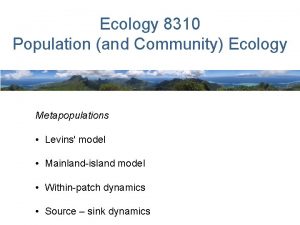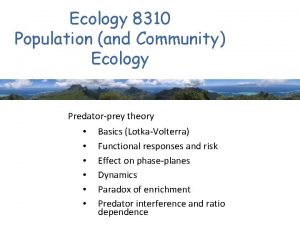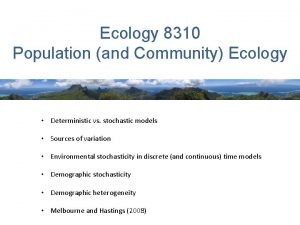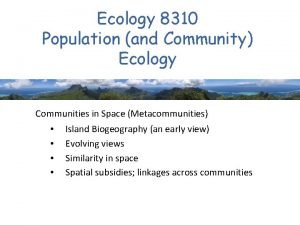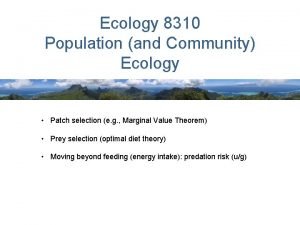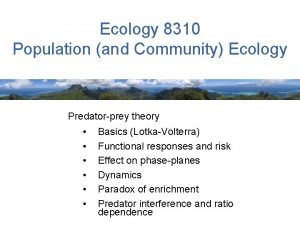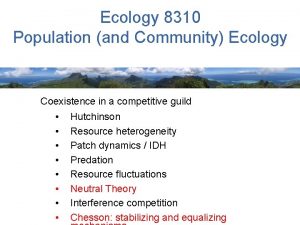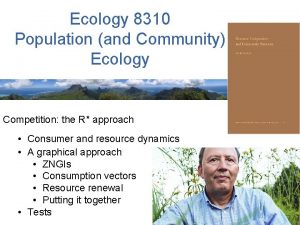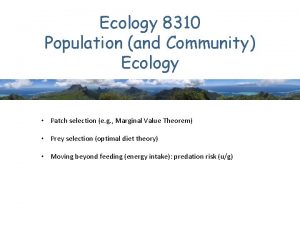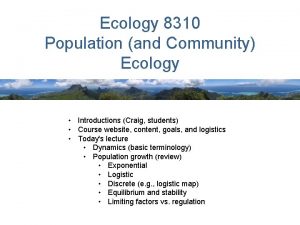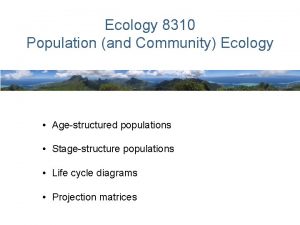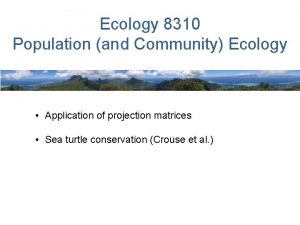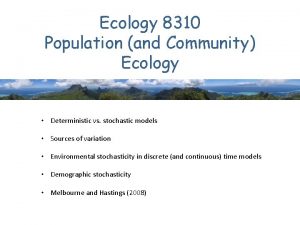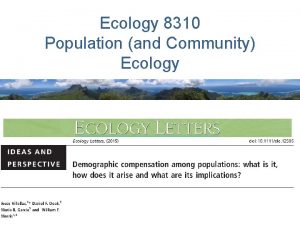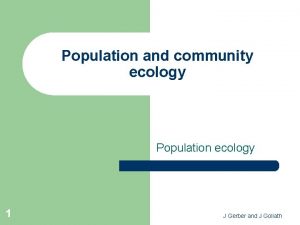Ecology 8310 Population and Community Ecology The effects































- Slides: 31

Ecology 8310 Population (and Community) Ecology The effects of diversity • • Background Tilman and Downing 1994 Species vs. functional diversity Foodwebs (instead of primary producers only) Form of BES relationship Niche complementarity vs. sampling effects Portfolio effect

How will a system's "function" be affected if you change the diversity of a guild of coexisting species…

"function"?

More diverse systems might: • Be more resistant or resilient • Provide greater ecosystem function (fluxes) • Provide greater ecosystem services (benefits to society: water quality, food production, shoreline protection…)

WRT ecosystem functions, there are two divergent views: • Species are redundant • Species are complementary

Let's examine some empirical studies…


Approach 1. Severe drought 1987 and 1988 2. Long-term data on experimental plots that varied in plant species richness 3. Compared effect of drought (as function of species richness): 'resistence' 4. Response: Biomass 1988/Biomass 1986

Results:

Recovery? Response: Biomass 1992/Biomass 1986

Recovery?

Issues? 1. What generated the gradient in diversity ? • Nitrogen manipulation • more N increased plant biomass & decreased species richness • i. e. , species richness or nitrogen? 2. Species vs. functional diversity 3. Species (sampling effect) vs. niche complementarity? 4. "Averaging" (the portfolio effect)

Identity vs. Diversity:

Results Response Species Funct'nal diversity Plant biomass + Plant % N 0 Plant total N 0 Soil ammonia 0 Soil nitrate 0 Light penetration 0 + + -


• 8 eukaryote species richness levels (0 – 31) • 4 trophic levels • Measured: • Realized richness • Densities • Respiration (CO 2) • Decomposition • Invasions success


Ecosystem respiration:

Decomposition

Invasibility:



Niche complementarity vs. Sampling ("selection") effects Both tend to be present

Do polycultures perform better than monocultures of the "best" species (transgressive overyielding)? Yes niche complementarity No sampling effect 37% of studies show transgressive overyielding (63% do not)

More diverse communities have lower temporal variance

The portfolio effect


But might mean-variance relationships confound these patterns?


Tilman distinguishes three components: • Portfolio effect (baseline: species fluctuate independently; constant mean community biomass) • Covariance effect (e. g. , asynchrony) • Overyielding (biomass increases with S)

Diversity is important (but a variety of mechanisms operate)
 Trng 8310
Trng 8310 Faa form 8310-3
Faa form 8310-3 Chapter 4 section 1 population dynamics
Chapter 4 section 1 population dynamics Population ecology section 1 population dynamics answer key
Population ecology section 1 population dynamics answer key Population ecology section 1 population dynamics
Population ecology section 1 population dynamics Section 1 population dynamics answer key
Section 1 population dynamics answer key Organismal ecology
Organismal ecology Ecosystem vs community
Ecosystem vs community Clumped dispersion
Clumped dispersion Exponential growth equation ecology
Exponential growth equation ecology Concept 3 population ecology
Concept 3 population ecology Chapter 53 population ecology
Chapter 53 population ecology Chapter 36 population ecology
Chapter 36 population ecology Chapter 4 population ecology answer key
Chapter 4 population ecology answer key Population def ecology
Population def ecology Chapter 53 population ecology
Chapter 53 population ecology Characteristic of population
Characteristic of population Chapter 4 section 1 population dynamics answer key
Chapter 4 section 1 population dynamics answer key Population characteristics
Population characteristics What is population ecology
What is population ecology Population definition ecology
Population definition ecology Population distribution
Population distribution Population ecology
Population ecology Chapter 53 population ecology
Chapter 53 population ecology 5 evolution and community ecology
5 evolution and community ecology Chapter 5 evolution and community ecology
Chapter 5 evolution and community ecology Ecosystems interactions
Ecosystems interactions Biotic potential
Biotic potential Community ecology
Community ecology Chapter 3 section 1: community ecology answer key
Chapter 3 section 1: community ecology answer key Chapter 54: community ecology answer key
Chapter 54: community ecology answer key Definition of community ecology
Definition of community ecology





















